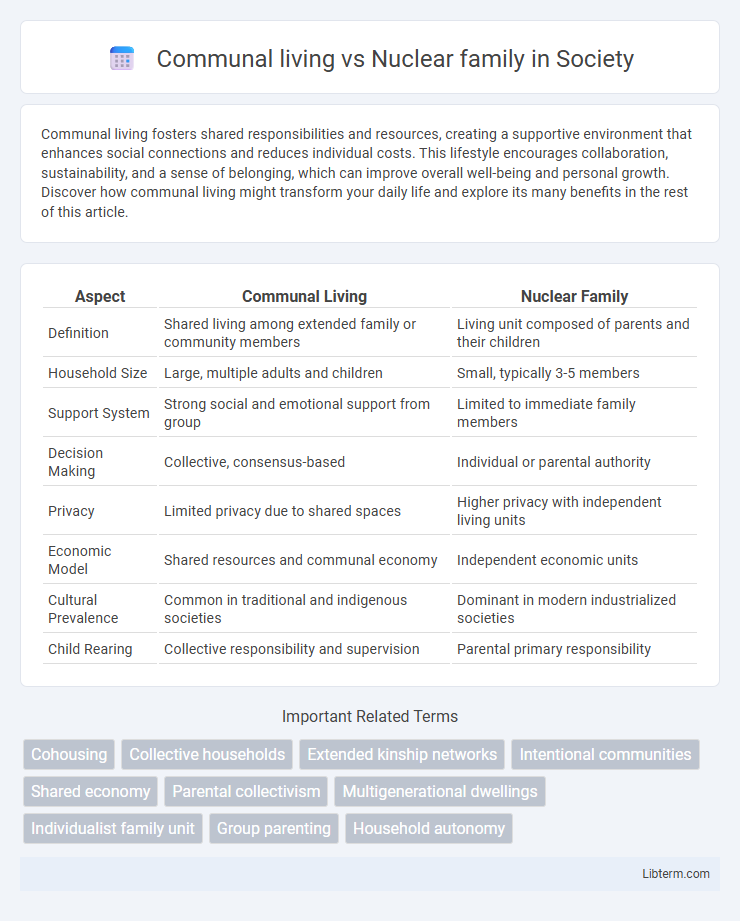Communal living fosters shared responsibilities and resources, creating a supportive environment that enhances social connections and reduces individual costs. This lifestyle encourages collaboration, sustainability, and a sense of belonging, which can improve overall well-being and personal growth. Discover how communal living might transform your daily life and explore its many benefits in the rest of this article.
Table of Comparison
| Aspect | Communal Living | Nuclear Family |
|---|---|---|
| Definition | Shared living among extended family or community members | Living unit composed of parents and their children |
| Household Size | Large, multiple adults and children | Small, typically 3-5 members |
| Support System | Strong social and emotional support from group | Limited to immediate family members |
| Decision Making | Collective, consensus-based | Individual or parental authority |
| Privacy | Limited privacy due to shared spaces | Higher privacy with independent living units |
| Economic Model | Shared resources and communal economy | Independent economic units |
| Cultural Prevalence | Common in traditional and indigenous societies | Dominant in modern industrialized societies |
| Child Rearing | Collective responsibility and supervision | Parental primary responsibility |
Introduction to Communal Living and Nuclear Families
Communal living involves a group of individuals or families sharing resources, responsibilities, and living spaces to foster cooperation and social support, often emphasizing collective well-being and shared values. In contrast, nuclear families consist of two parents and their children living independently from extended relatives, focusing on privacy, autonomy, and direct parental care. Both living arrangements shape social dynamics, economic strategies, and cultural practices in distinct ways.
Historical Context of Family Structures
Communal living, historically prevalent in agrarian and tribal societies, emphasized collective child-rearing, shared resources, and cooperative labor, contrasting sharply with the more isolated nuclear family model that emerged during industrialization. Nuclear families, consisting typically of two parents and their children, became dominant in urbanized societies due to increased mobility, economic pressures, and the rise of wage labor systems. These shifts reflect broader socio-economic transformations influencing family structures from extended kin networks toward more individualistic household units.
Core Principles of Communal Living
Communal living centers on shared resources, collective decision-making, and mutual support, fostering a strong sense of community and interdependence beyond the typical nuclear family structure. Core principles include egalitarianism, cooperation, and shared responsibilities, which contrast with the individualism and privacy emphasized in nuclear families. This model promotes sustainable living and social cohesion by prioritizing the needs of the group over individual preferences.
Key Features of Nuclear Family Dynamics
Nuclear family dynamics are characterized by a small, self-reliant unit typically consisting of two parents and their children, emphasizing independence and privacy. Decision-making is usually centralized within the immediate family, promoting autonomy and streamlined communication. Emotional bonds are intensely focused, fostering close-knit relationships but often limiting extended support networks common in communal living arrangements.
Social and Emotional Benefits Comparison
Communal living fosters stronger social bonds through shared responsibilities and frequent interactions, enhancing emotional support networks and reducing feelings of isolation. Nuclear families often offer more privacy and individualized attention, but may face challenges in social connectivity and emotional resilience during crises. Studies indicate communal living environments boost collective well-being and provide diversified emotional resources, while nuclear families prioritize focused caregiving and intimate family dynamics.
Economic Advantages and Challenges
Communal living offers economic advantages through shared resources, reduced individual expenses, and collective purchasing power, which can lower housing and utility costs significantly. However, challenges arise in coordinating financial responsibilities and potential conflicts over resource allocation, which can complicate budgeting and economic planning. In contrast, nuclear families benefit from straightforward financial decision-making but often face higher per capita costs for housing, childcare, and living expenses.
Parenting and Child Development Outcomes
Communal living fosters collaborative parenting, providing children diverse role models and shared responsibilities that enhance social skills and emotional resilience. Nuclear families offer focused attention and consistency, promoting secure attachment and personalized developmental support tailored to the child's needs. Studies indicate children in communal settings benefit from broader social interactions, while nuclear family environments often yield higher academic achievement and structured discipline.
Conflict Resolution and Decision-Making
Communal living often employs collective decision-making processes that emphasize group consensus, reducing individual conflicts through shared responsibilities and open communication channels. In contrast, nuclear families typically resolve conflicts within a smaller, more private setting, where decisions are made predominantly by parental figures, which can lead to quicker resolutions but may suppress diverse perspectives. The communal approach fosters collaborative problem-solving skills and mutual support, while nuclear family models prioritize autonomy and individualized conflict management strategies.
Impact on Mental Health and Well-being
Communal living fosters social support networks that can reduce feelings of loneliness and improve overall mental well-being by encouraging shared responsibilities and collective problem-solving. In contrast, nuclear families may experience increased stress due to limited social interaction and higher individual burdens, potentially impacting mental health negatively. Studies indicate that communal living arrangements promote stronger emotional resilience and lower rates of depression compared to isolated nuclear households.
Future Trends in Family and Communal Living Models
Future trends in family and communal living models indicate a growing shift toward combined or extended family structures, blending elements of communal living with traditional nuclear family setups to enhance social support and resource sharing. Advances in technology and increased urbanization promote the development of co-housing communities and multi-generational homes that address economic pressures and foster stronger interpersonal connections. Sustainability concerns and mental health awareness also play pivotal roles in encouraging these innovative living arrangements that prioritize collaboration and collective well-being over individual isolation.
Communal living Infographic

 libterm.com
libterm.com